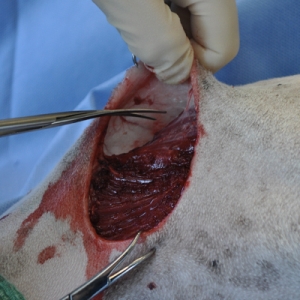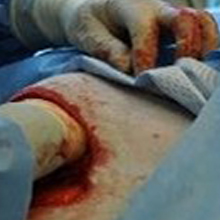Lumpectomies: Basics and Beyond
What is a lumpectomy:
Lumpectomy is informal terminology for the removal of a dermal or subdermal mass. A lumpectomy is a very common procedure performed in small animal practice.
Situational Awareness
Unfortunately, veterinary students receive little formal instruction on lumpectomies when one considers how common this procedure is in small animal practice. In most cases, ‘winging it’ by applying a few basic surgical principles and some common sense will suffice to achieve a successful outcome. But why not increase your level of confidence by having the appropriate information? Also, concerns like: Will the site close? Will it stay closed? Can also be alleviated by having a solid understanding of how to manage it.

Get ready to perform a Lumpectomy
All the information you need.
In depth guide and more.
Step by step explanations of the procedure.
In depth guide and more.
Step by step explanations of the procedure.
This content is designed for veterinary professionals. If you are a pet owner, please consult your vet if you have any questions about a surgery.
Surgical Considerations:
Reduce tension on skin edges:
- Identify tension patterns
- Understand how to properly undermine
- Undermine sufficiently
Reduce wound dehiscence:
- Reducing tension on the skin edges
- Preserving vasculature
- Proper use of instruments/gentle tissue handling
Have a plan for closing after larger masse removal:
- Be prepared (pre and intra op) to undermine more aggressively
- Be prepared to do a single pedicle advancement flap
- Be prepared to use a drain
- Be prepared to manage as open wound (prepare client)
What the clients need to know:
- The incision will take approximately 10-14 days to heal
- Activity should be minimal until incision has healed to prevent undue tension or fluid build up.
- Proper care of drain is readily managed by pet owners.
Step by Step Undermining

- Figure 1
Undermining is easily and commonly done using fine scissors such as Metzenbaums. The undermining should be deep to cutaneous trunci or fascial planes. Blood vessels should be preserved if possible.

- Figure 2
Skin can also be bluntly undermined using the fingers to gently push through the loose connective tissues located deep to the superficial fascial plane or cutaneous trunci muscle.

- Figure 3
It is important to undermine sufficiently to remove tension at the skin edges
Get ready to perform a Lumpectomy
Preferred instrumentation:
- General instrument pack.
- Extra towel clamps to help manipulate and approximate skin.
- Jackson-Pratt drain and grenade over the Penrose drain.
Post-operative Considerations:
- Restricted activity for 10-14 days to allow skin to heal.
- Potential Elizabethan collar or bandage to protect the site from being damaged by the patient.
- Recheck and remove sutures in 10-14 days
- Drain covering and management if necessary.
- Client education on drain management.
What you get when you register:
- Detailed, narrated information on
- Basic principles of excising benign dermal and subdermal masses
- How to successfully manage more aggressive dermal and subdermal masses
- Burying a subcutaneous knot: why and how
- How to properly undermine so that the larger lumps are not a problem
- Single pedicle advancement flaps
- Free skin grafts
- Placing drains
- Reconstructive techniques to avoid
- Areas that are more difficult and how to manage (if you can’t avoid)
- Back up plans if a primary closure is elusive.
Price: $250 CAD
Q & A
How long will it take for my dog to heal from a lumpectomy?
- Most lumpectomy site will heal in 10-14 days
- Larger lumps that require more reconstruction techniques usually also take about 14 days barring any complications such as fluid accumulating under the skin.
Will the pet require a bandage after a lumpectomy? if so for how long?:
- Most lumpectomies do not require bandages. However a veterinarian may opt to place a bandage to help protect the incision from being licked or to try and minimize motion and/0r fluid accumulation at the site surgical site
Subscribe to our newsletter
Workshops & Courses
Blog
 The Secret to having the Bandage stay Above the StifleJuly 3, 2024 - 1:44 pm
The Secret to having the Bandage stay Above the StifleJuly 3, 2024 - 1:44 pm Common Mistakes made by Veterinarians when doing the Drawer TestJune 26, 2024 - 9:22 am
Common Mistakes made by Veterinarians when doing the Drawer TestJune 26, 2024 - 9:22 am Burying the end knot in a continuous subcutaneous suture patternJune 19, 2024 - 7:35 pm
Burying the end knot in a continuous subcutaneous suture patternJune 19, 2024 - 7:35 pm Creating Donuts for your BandagesJune 12, 2024 - 3:15 pm
Creating Donuts for your BandagesJune 12, 2024 - 3:15 pm The Knotless Suture PatternJune 5, 2024 - 2:45 pm
The Knotless Suture PatternJune 5, 2024 - 2:45 pm

